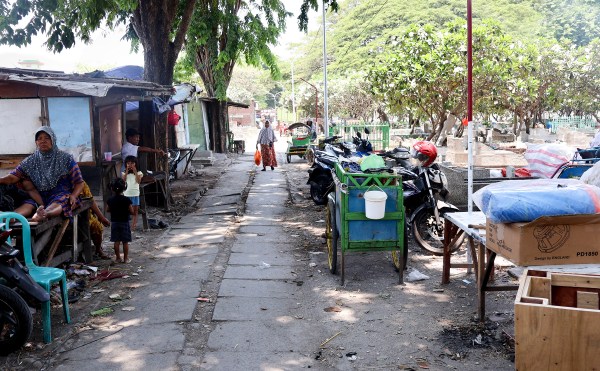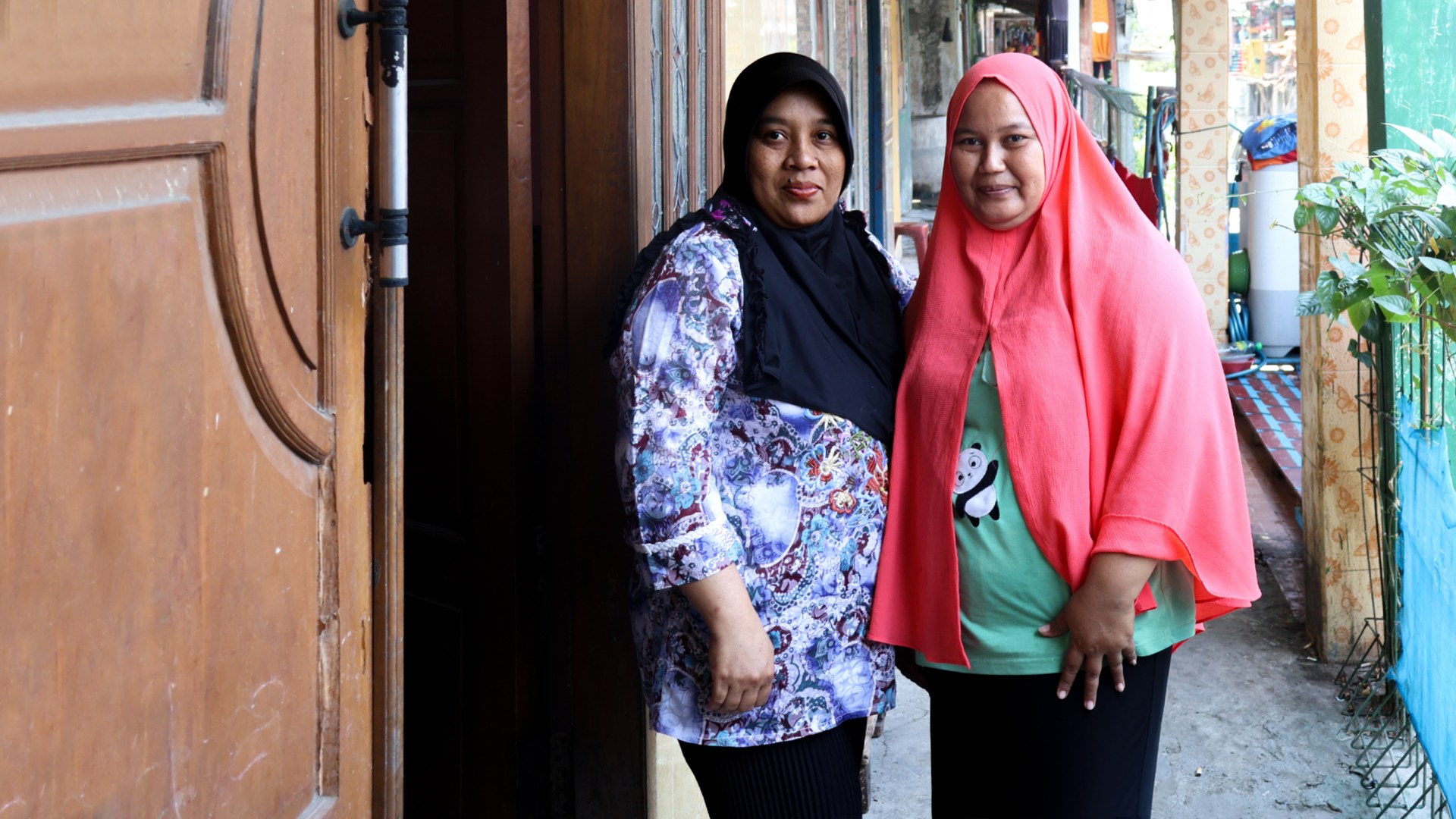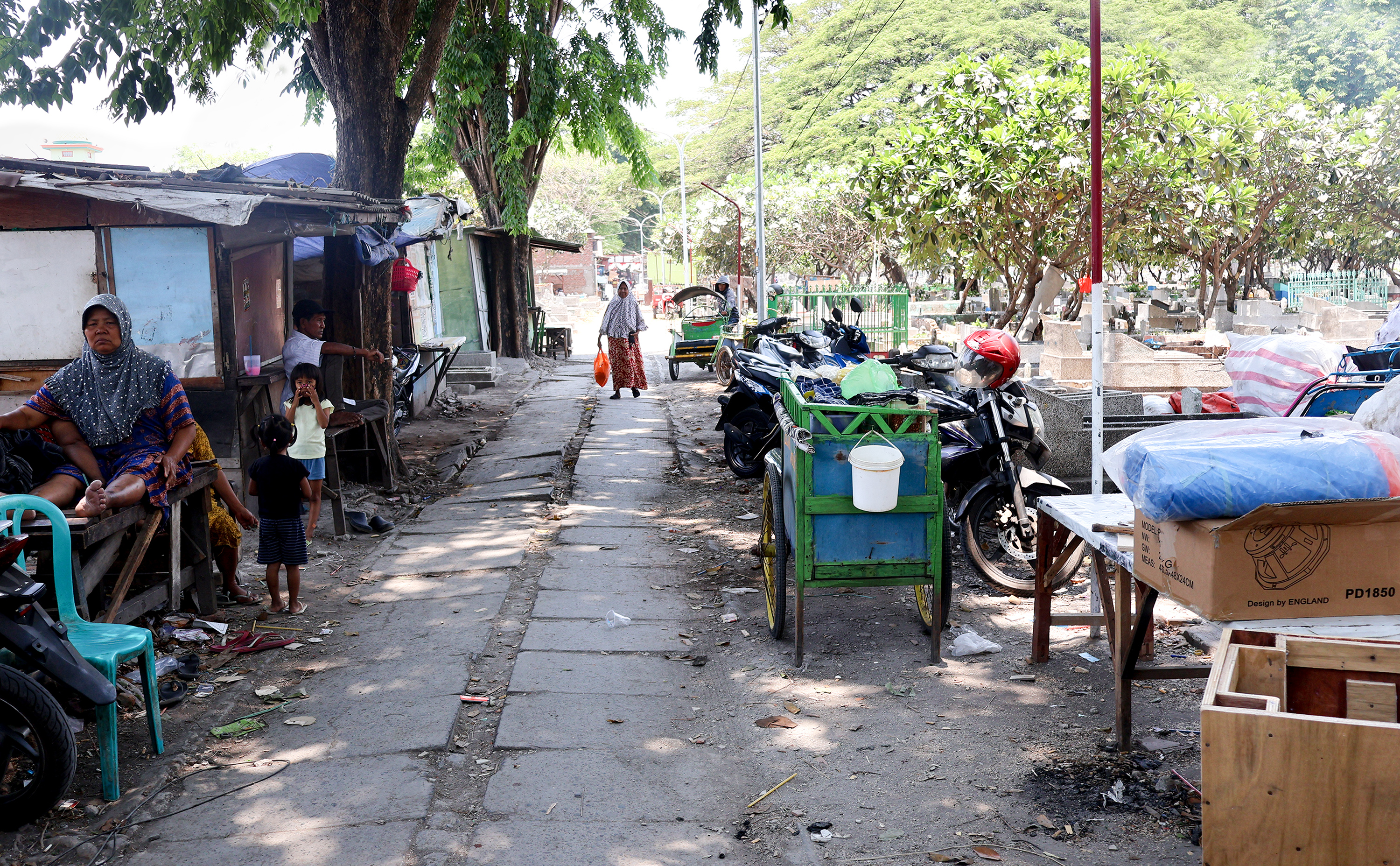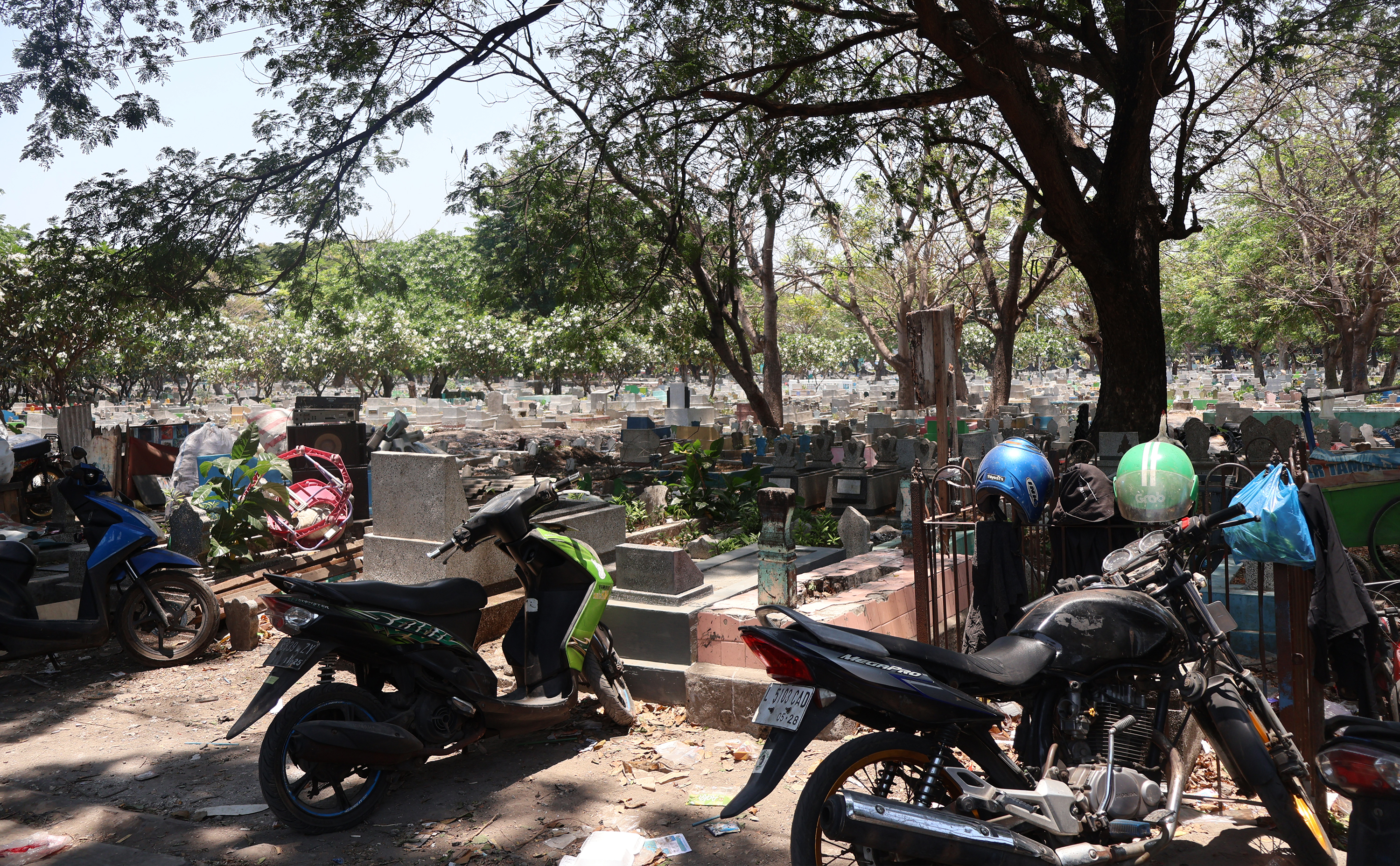Inside a cemetery in West Java, a woman rests on a mattress laid on top of a gravestone beneath the oak trees. The graveyard is home not only to the dead but to the living poor, who have nowhere else to go.
Residents of the Rose Cemetery community collect garbage, drive pedicabs, or clean graves by day. In the northern section of the cemetery, about 200 families live in brick and tin buildings lining a ditch filled with trash and milky sewage water. At night, many women resort to prostitution to provide for their families. Their daughters are often sold—or kidnapped—into the sex trade. (CT changed the names of the cemeteries and only used the first names of its residents for security reasons.)
Compassion First (CF) offered tutoring, parenting classes, and cooking classes for the community on a blue covered porch in the cemetery complex. Recently they moved to a new community center nearby. CF focuses on fighting sex trafficking in Indonesia, and here at the cemetery, that means community development among families vulnerable to exploitation.
Susi and Mala, two mothers who have lived in the community their whole lives, noted that neighbors rarely knew one another in the past. CF arrived during the COVID-19 pandemic—initially to provide food for the community and scholarships to the children. Since then, the neighborhood has become much more close-knit and better resourced. For young girls, this could make the difference between whether they are trafficked or not.
Susi learned from the cooking class how to make seblak (a spicy dish made of wet crackers and meat or seafood, smothered in sambal chili paste) and now sells it to supplement her income. Mala learned about the five love languages in the parenting class and this helped her relate to her children and husband. “I learned that kids are like durians,” she said. “Spiky on the outside and soft inside.”
Mala said that since CF started its program, all the moms have started small businesses.
“Usually a group comes for a while [then leaves], but YKYU comes here continually,” Mala said. (YKYU is the Indonesian name for CF.) “They really care for us, both the kids and the moms.”
Staying in a community “continually” is what makes Compassion First effective in Indonesia and unique among international anti–sex trafficking efforts there. Beyond the two community development programs in West Java cemeteries, the Oregon-based organization operates two shelters for girls rescued from sex trafficking and a transitional home.
They also work with law enforcement to help return trafficked girls to their homes, partner with other groups to monitor ferry terminals for traffickers, and arrange trainings for police, churches, and local communities on how to spot trafficking.
The work is slow and challenging, and opposition from mafia-linked traffickers and corrupt police had prompted CF leaders to consider giving up. But, amid their weariness, they say they’ve seen God bring the right people and the right resources at the right time.
“We talk about our work … in terms of everyday aftercare, everyday advocacy,” said Traci Espeseth, Compassion First’s director of development. “And it really comes back to just being faithful in showing up day in and day out and saying yes to God’s invitation.”


Providing resources to victims of child sex trafficking
An estimated 70,000–80,000 Indonesian children are victims of sexual exploitation, according to the US State Department’s 2021 Trafficking in Persons (TIP) report on Indonesia. Because the archipelago is expansive, girls are frequently transferred between the 6,000 inhabited islands, making it difficult to track them down and bring them home.
Sex traffickers often use debt or false offers of employment to trap girls—especially those from poor families—into sex work. Tourist spots like the island of Bali are destinations for foreign and local child sex tourism.
In 2022, the TIP report ranked Indonesia as Tier 2, meaning that while the government hasn’t reached the minimum standards for eliminating trafficking, it is making a concerted effort.
The government has come a long way since CF founder and CEO Mike Mercer first started to work in Indonesia in 2010. Before that, Mercer worked on post–Hurricane Katrina relief through his Foursquare church in Beaverton, Oregon. After learning about sex trafficking in Southeast Asia, he sought to work in an underserved country. His contacts told him that Indonesia had a great need, as other NGOs have tried and failed due to the difficulty of the work.
While other anti–sex trafficking groups congregated in Thailand and Cambodia, he headed to Indonesia, where his denomination had 13,000 churches. He knew that to succeed, he’d need local partners.
In 2010, CF opened a shelter for child victims of sex trafficking in the Christian-majority province of North Sulawesi. Due to the poverty in the province and the fact that women from the region are light-skinned (which is viewed as attractive in Indonesia), it has the second-highest number of women trafficked in Indonesia.
CF built connections with law enforcement in the city, especially the head of the investigative unit for women and children. “We were hand in glove from the beginning because we were aligned,” Mercer said. “I think that was the provision of God.”
Police were eager for CF to build a shelter as they had recently busted a sex trafficking ring and sent the girls back to their homes in North Sulawesi. Yet because the families and communities weren’t ready to receive them—some came from unsafe homes and many were stigmatized for their past—they struggled to reintegrate into society, and all the girls were re-trafficked.
The police were demoralized. So when CF contacted them about providing aftercare for rescued girls, local law enforcement were eager to help.
CF’s growing pains
With funds donated from the US, CF hired Indonesian staff, trained them with the help of veteran sex trafficking groups like Transitions Global, and started housing girls. But it wasn’t nearly enough.
“At first, we had to make it up as we went,” said Winda Winowatan, president of CF Indonesia. A North Sulawesi native, Winowatan worked in the church before joining the organization. She noted that while they had models from other parts of the world, locally, “we had no one to learn from.”
Ervillia Valentina, one of the first house moms at Sarah’s House in North Sulawesi, experienced many of those challenges firsthand. She lived 24/7 at the shelter with another house mom and two security guards. Even on her days off, Ervillia slept at the shelter. Together, they cared for four girls.
One night, all four ran away. “They were terrified because they were going through their legal cases,” where they needed to testify against their traffickers, Ervillia said. These attempts at prosecution would upset traffickers, who are closely tied to the mafia. Ervillia remembers mafia members revving their motorbikes outside the shelter to intimidate them. At times, the girls and the CF team needed to spend the night at a hotel.
When a girl ran away, case managers checked in with their parents, friends, and social media to find out where they’d gone. Then they brought them back and discussed whether the shelter was the right place for them. The first time, all four girls decided to return to the shelter.
One time after a girl ran away and Ervillia found her, the girl grabbed a knife from the kitchen and threatened to kill Ervillia. From then on, CF decided that house moms should not stay at the shelter 24 hours a day but live outside and trade shifts with others.
Valerie Bellamy, CF’s director of operations, said that although the girls choose to enter the shelter, most have tried to run away. Every time, CF will go find them again: “There comes a point when she realizes that she’s worth going after.”


Miraculous interventions
At times, the dangers have been grave. Mercer noted that one of their first court cases in 2011 took place in a rural city, and CF faced opposition not only from the mafia but from the corrupt police force. During the trial, one girl testified and named seven government officials whom she had been sold to. Several were sitting in the courtroom.
“It’s [times like this] where everybody on our team should have just … gone home, everybody should have quit,” Mercer said. “One of the ways we know the hand of God is with us is that all of those people still work for us today. It’s phenomenal.”
Their story landed in the newspaper, which was seen by an official from the US embassy, who asked for a meeting with Mercer and CF staff. A photo from that meeting was publicized, and suddenly all the opposition stopped as the police realized the world was watching. Through CF’s connections with the embassy in Indonesia, they were able to invite the head of the Portland Police Bureau and other US government officials to train local Indonesians on how to investigate sex trafficking cases and how to identify and engage with the victims.
“Westerners don’t actually get to go in and kick down doors,” Mercer said. “Anybody who says they do that is acting dangerously. … We are here to partner with our friends who are legally able to do that work, and then we’re here to take care of the humans that they intervene for.”
Becoming a government model
Over time, CF has been able to improve their care for the girls as well as their staff. Mercer said they realized they needed to raise a lot more money to hire more people and pay competitive wages to keep them, due to the hazards of the job. By providing their staff with extensive training and support for the secondhand trauma that they encounter, they have prevented the staff turnover that plagues other groups. Today, CF has more than 100 staff, and 90 percent are Indonesian.
At the home, CF provides the girls with trauma-based counseling, homeschooling, legal advocacy, and opportunities to explore their skills and hobbies so that they can pursue different career paths in the future.
“There’s a need to transition from surviving from day to day to thinking about tomorrow, what your dreams are,” Bellamy said. Referencing the typical girl they serve, she noted, “We wish trafficking wasn’t part of her story, yet her future is brighter than it has ever been.”
At the same time, they work with the girls’ families to make sure they are ready for their daughters to return. In some cases, the parents were the ones who decided to sell their daughter in the first place, so CF needs to find another safe family in the community.
Since its founding, CF has helped 67 girls and seen 24 cases go to trial, with a total of 23 traffickers convicted. Some cases resulted in multiple convictions and some with none.
The Indonesian government now uses Sarah’s House as a model. Winowatan has created step-by-step instructions for the North Sulawesi government to deal with trafficking victims.
CF has also seen fruit from its partnership with local law enforcement: In 2015, a government official in the province of Papua told Mercer that since doing a training two years earlier, they had seen a 50 percent reduction in the trafficking of girls from North Sulawesi to Papua.
And since 2022, CF has partnered with Love Justice International to monitor ferry terminals in North Sulawesi. Mercer heard that traffickers are now unable to get girls off the boats in North Sulawesi, so they’ve had to either find girls from another province or take more expensive routes.
Going where they’re invited
The needs elsewhere in Indonesia are many, but Mercer doesn’t want the group to dictate where they go to help. Instead, they wait to be invited into different spaces.
They expanded their work into West Java cemeteries in 2012 only after female sex workers invited them into their community. Mercer had heard that cemeteries in urban centers are the end of the road for sex workers, as the women there are either stuck in a generational cycle of prostitution or have “matriculated through this nefarious network of prostitution and they age out of everything,” Mercer said. “This is the last stop.”
With the leader of a local Christian ministry, a person of peace, and a box of sandwiches, CF staff visited what they have called “Marigold Cemetery” after dark and got to know the women selling themselves among the gravestones. On their second visit, they asked if they could organize and invite the women to a Christmas gala. The women agreed.
From there, relationships developed. CF started to better understand their needs, and in 2015, they opened their first community center near the cemetery, providing scholarships, tutoring, and classes. Every year, they continue to hold a gala, now for Thanksgiving instead of Christmas.
CF’s entrepreneurship class teaches adults and teens how to make journals using leftover fabric from boldly patterned Indonesian batiks. The journals are then sold in the US or to tourists visiting Indonesia, and all the proceeds return to the students.
One member of the class, 22-year-old Asya, has come to the center since she was in the sixth grade. She started making journals as a teen in between taking classes at the center. From the skills she’s learned from that class, including managing finances and photographing products, she’s started small businesses selling satays on the street and creating flower arrangements for special events.
What she appreciates most is the community she’s found in the class. “I share everything with them,” Asya said.
Expansion in Java
The invite into the Rose Cemetery community, where Mala and Susi reside, came when COVID-19 devastated the already-struggling community. Many residents lost their jobs and could not feed their children.
CF helped provide food for those families and invited them to join the Thanksgiving gala at the Marigold Center. At the event, the families told staff they also wanted the same resources and opportunities. CF eagerly agreed.
“I wish in 1997 YKYU was here so I could also study instead of getting married at 16,” Mala said wistfully. She dropped out of school after her first year of junior high because her dad died, and the family had no money for school. “I would rather have gone to school, so that’s what I tell my kids to do. … I ask them to join [YKYU] programs so that they can get support for their education, because as a mom, I can’t help them.”
As police connected CF with more rescued girls from the Muslim-majority West Java, CF realized they needed to open another aftercare home in the region. This would allow the girls to stay within their community and quell concerns among Muslim parents that their daughters would be “Christianized” if they went to Christian-majority North Sulawesi.
So in 2019, CF opened a second shelter called Grace House. Ervillia, who worked at the home as a program coordinator, said that they never forced Christianity on their mostly Muslim girls but gave them opportunities to learn about Jesus. Once a week, they hold “share nights” where pastors and volunteers share about their lives and tell stories from the Bible.
“One of the girls in our care program said she felt really loved and really accepted by our staff, and so that makes her love being in the program,” Ervillia said. “That’s how we see her life change and her self-worth change.”
While Grace House closed in 2021 due to landlord issues, around the same time, a pastor in West Java donated a property to CF, inviting them to build a shelter there to help local girls. Today, that center cares for three girls.
In the future, Mercer sees CF continuing to step into new spaces where their services are needed. The Indonesian government had said they hoped Compassion First would work in every province in the country. Currently, they are in four—including a case management office in Bali.
“As Indonesia continues to invite us to serve, then that’s what we’ll be doing,” Mercer said. “We grow out of assignment, not out of ambition.”








































